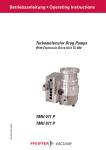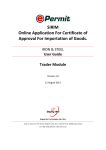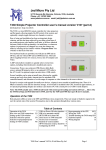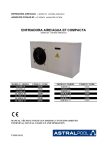Download Unique Micro Design Advanced Thinking Products Model 164 Quad
Transcript
Unique Micro Design Advanced Thinking Products Model 164 Quad Coupler User Manual Document reference : DOC-M164-UM UMD Part Number : 6-0164-993-4 Issue 1 - First release Revision 2/12/92 Unique Micro Design DOC-M164-UM Unique Micro Design Advanced Thinking Products Model 164 Quad Coupler Document reference : DOC-M164-UM UMD Part Number : 6-0164-993-4 Issue 1 - First release Revision 2/12/92 Unique Micro Design Pty Ltd (A.C.N. 007 419 490) 2 / 23 Wadhurst Drive Boronia Vic 3155 Australia Tel +61-3-887-1022 Fax +61-3-887-0734 Copyright (C) 1992 Unique Micro Design P/L Issue 1 2/12/92 2 Unique Micro Design Issue 1 DOC-M164-UM Issue Date Comments 1 2/12/92 First release 2/12/92 3 Unique Micro Design DOC-M164-UM 1. Introduction 1.1 Scope This manual provides installation and configuration details for the Unique Micro Design Model 164 Quad Coupler. 1.2 Overview The Model 164 Quad Coupler is a general purpose microcomputer based device which provides three full duplex serial ports and a configurable parallel I/O port. Its multiple operating modes are selected by a series of switches. This manual describes the Model 164 operating with the standard firmware. Other firmware options can be provided to suit specific applications. Issue 1 2/12/92 4 Unique Micro Design DOC-M164-UM 1.3 Description S3 D E S1 Quad Coupler Advanced Thinking Products +DC GND A B C PARALLEL I/O Model 164 S2 Power Status The three serial ports on the Model 164 are designated S1, S2 and S3. A parallel port is also provided which can be configured either as an input, designated PI, or configured as an output, designated PO. The Model 164 can operate in a number of modes as configured via the externally accessible switches. These switches are arranged in five banks designated "A" to "E" with each bank comprising four switches, numbered 1 to 4. For example, switch 2 of bank "B" is designated "B-2". Issue 1 2/12/92 5 Unique Micro Design DOC-M164-UM There are two indicators - power and status. The power indicator lights when power is applied to the unit. The status indicator flashes once on successful power up and flashes in various sequences to indicate error and other conditions. Issue 1 2/12/92 6 Unique Micro Design DOC-M164-UM 1.4 Modes of operation The Model 164 is a multi-functional device. It can operate as a: * serial to parallel converter * parallel to serial converter * ASCII to PC TERM converter * simple baud rate converter * serial wedge * printer sharer * code activated switch There are four basic operating modes with the Model 164, numbered from 1 to 4. These modes determine how the parallel I/O and serial ports behave. These modes are selected by switches C-1 and C-2 which are detailed in chapter 2. The following sections describe some typical configurations. 1.5 Parallel to serial converter Mode 1 has the parallel port configured as an input (ie it connects to the printer port of a PC). Input into this port is output to S1, thereby converting parallel input to serial output. Issue 1 2/12/92 7 Unique Micro Design DOC-M164-UM Optional PC Term Conversion Parallel Port Serial Port S1 Serial Port S2 Serial Port S3 1.6 Serial wedge 1 also offers a serial wedging function. Here, S1 and S2 can communicate bidirectionally. Serial port S3 inserts its input into this stream by either outputting to S1 (ie where communication is full duplex with the terminal) or both S1 or S2 (where communication is half duplex). In this way a bar code scanner can insert its data between a terminal and a host computer. Mode Issue 1 2/12/92 8 Unique Micro Design DOC-M164-UM Parallel Port Optional PC Term Conversion Serial Port S1 Serial Port S2 Serial Port S3 Scanner 1.7 PC TERM conversion In mode 1, ASCII input to S3 can optionally be converted to PC TERM output, allowing bar code scanners and the like to be inserted in between terminals running PC TERM and the multi-user system. 1.8 Serial to Parallel converter With mode 2 the parallel port is configured as an output (ie it connects to a parallel printer). This mode provides serial input conversion to parallel output. Issue 1 2/12/92 9 Unique Micro Design DOC-M164-UM Parallel Port Optional PC Term Conversion Serial Port S1 Serial Port S2 Serial Port S3 As Mode 2 has input from serial port S2 directed to S1, a host computer could communicate with a parallel printer whilst receiving input from a bar code scanner. Issue 1 2/12/92 10 Unique Micro Design DOC-M164-UM 1.9 Code activated switch 3 provides code activated switch functionality where parallel input is interpreted for codes which direct output to a selected serial port. Mode Parallel Port Serial Port S1 Serial Port S2 Serial Port S3 1.10 Printer sharer 4 provides printer sharing functionality. Here input to S1, S2 and S3 is directed to the parallel output port. Port contention is resolved by time out, ie if say, S1 is outputting to the printer then S2 is locked out from sending information until S1 finishes its job. Job completion is determined by having no activity for a selected time out period. Mode Issue 1 2/12/92 11 Unique Micro Design DOC-M164-UM Parallel Port Serial Port S1 Issue 1 2/12/92 Serial Port S2 Serial Port S3 12 Unique Micro Design DOC-M164-UM 2. Configuration 2.1 Mode 1 - Serial Wedge/Parallel to Serial Converter With mode 1, the parallel port is configured as an input with its data being directed to S1 providing parallel to serial conversion. Mode 1 also provides serial wedging. Here S1 and S2 are cross-linked which provides Host to Terminal communications. S3 is wedged between S1 and S2, allowing scanner (or other) input into the data stream. Optional PC TERM conversion may be enabled on S3 input to allow ASCII devices to communicate with PC TERM Host systems. C-1 C-2 OFF OFF C-3 C-4 OFF OFF ON ON OFF ON Issue 1 2/12/92 Mode 1 S3 no conversion S3 to S1 (full duplex) S3 to S1 & S2 (half duplex) S3 PC Term conversion (S3 to S1) No intercharacter delay Intercharacter delay of 30 mS 13 Unique Micro Design DOC-M164-UM 2.1.1 PC TERM conversion handshake When PC TERM conversion is invoked, software handshake (when enabled) will use the PC TERM protocol. Hardware handshaking operates as normal. The Host (running PC TERM) must be connected to S1 and the terminal to S2. The software handshake only operates for data travelling from S1 to S2, ie there is no terminal/scanner to Host software flow control. For this reason, switch C-4 enables an intercharacter delay to slow down data input from S3 if needed. 2.1.2 S3 blocking in modes 1 & 2 In modes 1 and 2, input received on serial channel S3 may be blocked. Here input is buffered until a terminator character is received, which in the standard firmware option is the carriage return control character (ie hexadecimal 0D, decimal 13). Once the terminating character is received, the optional preamble character string is output followed by the buffered characters (excluding the terminating character) followed by the optional postamble character string. The received block may be manipulated as determined by the block modifier routine given in the table below. A Spectra-Physics bar code symbology id stripping modifier is provided as standard, other routines can be provide upon request. Issue 1 2/12/92 14 Unique Micro Design DOC-M164-UM Input from Spectra Physics Scanner FF12234567890<CR> <STX>1234567890<ETX> Output Example of block modifer 2 with <STX> preamble and <ETX> postamble Block modifier routine 1 2 Description No manipulation Spectra-Physics bar code symbology id characters removed reserved 3 Block modifier routines Switch Setting A-3 A-4 OFF OFF ON OFF OFF ON ON ON A-1 OFF ON OFF A-2 OFF OFF ON Issue 1 2/12/92 Blocking type none [preamble] [modified BLOCK using routine 1] [postamble] [preamble] [modified BLOCK using routine 2] [postamble] [preamble] [modified BLOCK using routine 3] [postamble] Description Reserved Reserved Reserved 15 Unique Micro Design ON ON DOC-M164-UM Reserved Switch bank A in Modes 1 & 2 Blocking selection 2.1.3 Pre- and post-amble strings Switch bank B is used to select the pre- and post-amble character strings which are sent with blocked data in modes 1 and 2. Switch Setting B-1 OFF ON OFF ON B-3 OFF ON OFF ON where Preamble (valid when blocking enabled) B-2 OFF OFF ON ON none <STX> reserved reserved B-4 Postamble (valid when blocking enabled) OFF none OFF <ETX> ON <CR> ON <CR><LF> Code Hexadecimal Decimal <STX> 02 2 <ETX> 03 3 <LF> 0A 10 <CR> 0D 13 Switch definitions Pre/post-amble string selection Issue 1 2/12/92 16 Unique Micro Design DOC-M164-UM 2.2 Mode 2 - Serial to Parallel Converter With mode 2, the parallel port is configured as an output and accepts input from S1. The operation of S3 is the same as mode 1. C-1 ON C-2 OFF C-3 OF F ON Issue 1 2/12/92 C-4 Mode 2 S3 no conversion OFF S3 to S1 ON S3 to S1 & S2 S3 PC Term conversion (S3 to S1) OFF No intercharacter delay ON Intercharacter delay of 30 mS 17 Unique Micro Design DOC-M164-UM 2.3 Mode 3 - Code Activated Switch With mode 3, the parallel port is configured as an input. In this mode, the Quad Coupler is operating as a code activated switch. Input is accepted from the parallel port and is directed to either serial port S1, S2 or S3 as selected by a designated two character sequence. The first character in the sequence is the selection code which is determined by the binary pattern given in switch banks A and B. The second character determines which port to select: ASCII "1" (ie hexadecimal 31, decimal 49) selects S1, ASCII "2" selects S2 and ASCII "3" selects S3. If it is desired to send the selection code character through to the selected output port, two of these selection code characters need to be sent in sequence. With switch C-3 on, the selection code is only interpreted after a selected idle time. In this way, graphic data which may contain a valid selection code will not be interpreted. C-1 C-2 OFF ON C-3 OFF ON Issue 1 2/12/92 C-4 Mode 3 Selection code always interpreted Selection code only interpreted after idle timeout 18 Unique Micro Design DOC-M164-UM OFF 30 second idle timeout ON 10 second idle timeout OFF = 1 bit, ON = 0 bit A-1 A-2 A-3 A-4 bit 7 bit 6 bit 5 bit 4 B-1 bit 3 B-2 bit 2 B-3 bit 1 B-4 bit 0 Switch bank A and B in Mode 3 Selection code character 2.4 Mode 4 - Printer Sharer With mode 4, the parallel port is configured as an output. In this mode the Quad Coupler is operating as a printer sharer. Here the parallel output port is shared between the three serial input ports. Contention is resolved on a first come, first served basis with the first active serial port being assigned to the printer port. After no activity on the active input port for the selected idle timeout period, the parallel port is released for allocation to the next active serial port. Switch C-3 selects whether a form feed control character is sent after a print job. C-1 ON C-2 ON C-3 OFF Issue 1 2/12/92 C-4 Mode 4 No form feed sent after idle timeout 19 Unique Micro Design ON Issue 1 2/12/92 DOC-M164-UM Form feed sent after idle timeout OFF 30 second idle timeout ON 10 second idle timeout 20 Unique Micro Design DOC-M164-UM 2.5 Communications parameters For serial channel S3, the serial communications parameters are fixed at 9600 baud, 8 data bits with no parity and one stop bit with hardware handshaking. For serial channels S1 & S2, switch bank D and E determine their parameters. Switch setting D-1 D-2 ON ON OFF OFF OFF OFF OFF ON OFF ON ON OFF ON ON ON OFF Baud rate D-3 ON OFF ON OFF ON OFF OFF ON 38.4K 19.2K 9600 4800 2400 1200 600 300 Switch definitions Serial ports S1 & S2 baud rate Switch setting D-4 OFF ON Description Data bits 8 7 E-1 OFF ON Parity Enabled Disabled Issue 1 2/12/92 21 Unique Micro Design E-2 OFF ON Parity type Even Odd E-3 OFF ON S1 handshake Hardware DTR/CTS Software XON/XOFF E-4 OFF ON S2 handshake Hardware DTR/CTS Software XON/XOFF DOC-M164-UM Switch definitions S1 & S2 communications parameters Issue 1 2/12/92 22 Unique Micro Design DOC-M164-UM 4. Interfaces 4.1 Serial interfaces The serial interfaces use +/- 10 Volt levels. The pin consigment on the DB9 plug (male) is a subset of the PC/AT serial interface. Pin 1 2 3 4 5 6 7 I/O i/p o/p o/p o/p 8 9 case i/p - Description no connection RxD TxD DTR (input data stream handshake) Ground no connection RTS (ie always asserted) tied to +5V (can power external devices) CTS (output data stream handshake) no connection Ground Serial interface DB9 plug connector *1 * * * *5 *6 * * *9 Front view of DB9 plug Issue 1 2/12/92 23 Unique Micro Design DOC-M164-UM 4.2 Parallel Interface Pin 1 2 3 4 5 6 7 8 9 10 11 12 13 14 15 16 17 18-25 Description Strobe(-) Data 0 Data 1 Data 2 Data 3 Data 4 Data 5 Data 6 Data 7 Acknowledge(-) Busy Paper end Select Autofeed(-) Error(-) Initialise(-) Select input(-) Ground As output O O O O O O O O O I I I=GND I n/c O n/c I n/c O n/c O n/c - As input I I I I I I I I I O O O=GND O n/c I n/c O n/c I n/c I n/c - Parallel I/O interface DB25 socket connector 13 * * * * * * * * * * * * * 1 25 * * * * * * * * * * * * 14 Front view of DB25 socket Issue 1 2/12/92 24 Unique Micro Design DOC-M164-UM 4.3 External power interface The Model 164 requires 6 to 9 volts DC at 300 mA to operate. The external power connector connects to standard plug packs with centre pin grounded. Issue 1 2/12/92 25 Unique Micro Design DOC-M164-UM 4.4 Typical cables 4.4.1 To serial port of Printer PC serial port DB25 plug M164 serial port DB9 socket 2 --------------------2 3 --------------------3 7 --------------------5 20--------------------8 4.4.2 To serial port of PC PC serial port DB25 socket M164 serial port DB9 socket 2 --------------------2 3 --------------------3 5 -| 6 --------------------4 7 --------------------5 20--------------------8 Issue 1 2/12/92 26 Unique Micro Design PC serial port DB9 socket DOC-M164-UM M164 serial port DB9 socket 2 --------------------3 3 --------------------2 6 -| 8 --------------------4 5 --------------------5 4 --------------------8 | --6 4.4.3 To Centronics printer A standard PC parallel printer cable should be used to connect the parallel port of the Model 164 to a Centronics printer. 4.4.4 To parallel port of PC A straight through pin to pin DB25 plug to DB25 plug cable is used to connect the parallel port of a PC to the parallel input port of the Model 164. Issue 1 2/12/92 27



































